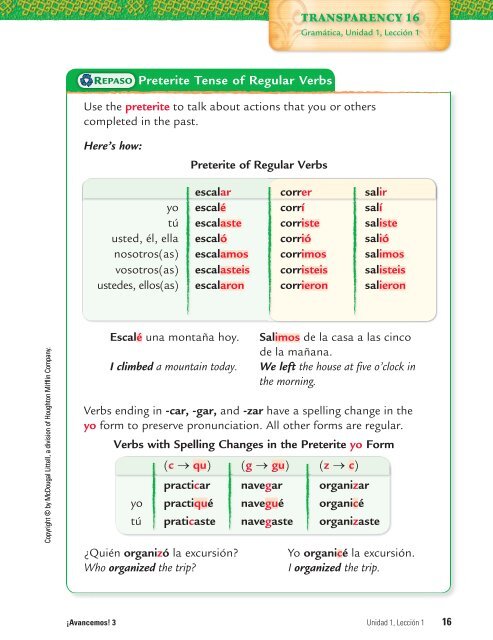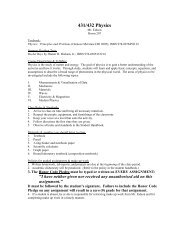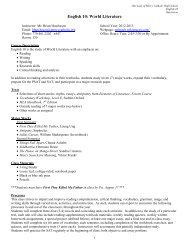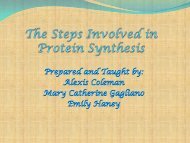subjunctive
subjunctive
subjunctive
- No tags were found...
You also want an ePaper? Increase the reach of your titles
YUMPU automatically turns print PDFs into web optimized ePapers that Google loves.
TRANSPARENCY 16Gramática, Unidad 1, Lección 1REPASOPreterite Tense of Regular VerbsUse the preterite to talk about actions that you or otherscompleted in the past.Here’s how:Preterite of Regular Verbsescalar correr saliryo escalé corrí salítú escalaste corriste salisteusted, él, ella escaló corrió saliónosotros(as) escalamos corrimos salimosvosotros(as) escalasteis corristeis salisteisustedes, ellos(as) escalaron corrieron salieronCopyright © by McDougal Littell, a division of Houghton Miffl in Company.Escalé una montaña hoy.I climbed a mountain today.Salimos de la casa a las cincode la mañana.We left the house at five o’clock inthe morning.Verbs ending in -car, -gar, and -zar have a spelling change in theyo form to preserve pronunciation. All other forms are regular.Verbs with Spelling Changes in the Preterite yo Form(c Æ qu) (g Æ gu) (z Æ c)practicar navegar organizaryo practiqué navegué organicétú praticaste navegaste organizaste¿Quién organizó la excursión?Who organized the trip?Yo organicé la excursión.I organized the trip.¡Avancemos! 3Unidad 1, Lección 1 16
TRANSPARENCY 17Gramática, Unidad 1, Lección 1REPASOIrregular PreteritesThe following verbs have irregular stems and irregular endings inthe preterite.Here’s how:*The stem of hacer is hiz- for the usted/él/ella form only. (Ella hizola tarea.)Copyright © by McDougal Littell, a division of Houghton Miffl in Company.j-Stem Verbsdijtraj-conduj-decirtraerconducirPreterite Endings-e -imos-iste -isteis-o -eronOther Irregular Verbs in the Preteritei-Stem Verbs u-Stem Verbs uv-Stem Verbs Preterite Endingshacer hic-/hiz-* haber hub- andar anduvquerer-e -imosquis- poder pud- estar estuv--iste -isteisvenir vin- poner pus- tener tuv- -o -ieronsaber supserand ir dar verfui di vifuiste diste vistefue dio viofuimos dimos vimosfuisteis disteis visteisfueron dieron vieronThe verbs dar and ver have regular-er/-ir preterite endings but withno written accent marks.¡Avancemos! 3Unidad 1, Lección 1 17
TRANSPARENCY 18Gramática, Unidad 1, Lección 2REPASOImperfect TenseIn Spanish, use the imperfect tense for actions that were ongoing,recurring, or incomplete in the past. How do you conjugate verbsin the imperfect?Here’s how:Regular Verbs in the Imperfectparar mantener reuniryo paraba mantenía reuníatú parabas mantenías reuníasusted, él, ella paraba mantenía reuníanosotros(as) parábamos manteníamos reuníamosvosotros(as) parabais manteníais reuníaisustedes, ellos(as) paraban mantenían reuníanCopyright © by McDougal Littell, a division of Houghton Miffl in Company.Siempre manteníamos el carro limpio.Irregular Verbs in the Imperfectir ser veriba era veíaibas eras veíasiba era veíaíbamos éramos veíamosibais erais veíaisiban eran veíanWe always kept thecar clean.Eran las ocho y veíamos lapuesta del sol.It was eight o’clock and wewere watching the sunset.¡Avancemos! 3Unidad 1, Lección 2 18
TRANSPARENCY 19Gramática, Unidad 1, Lección 2REPASOPreterite vs. ImperfectYou already know two tenses that refer to the past, the preteriteand the imperfect. How is each tense used?Here’s how:• Use the preterite tense to describe an action or series of actionscompletedin the past.Aquel día, Pedro fue a la playay jugó al voleibol playero.volleyball.• Use the imperfect tense for ongoing actions or states of being inthe past without focusing on their beginning or end. Always usethe imperfect to say what time it was or what the weather was likein the past.Elena siempre iba a la playacuando hacía buen tiempo.That day, Pedro went tothe beach and played beachElena always used to go to thebeach when the weather was nice.Copyright © by McDougal Littell, a division of Houghton Miffl in Company.• Sometimes you need the imperfect and the preterite in the samesentence.Use the imperfect to tell what was going on in the background.Use the preterite for the interrupting action or main event.Yo nadaba cuando Pedro llegóa la playa.I was swimming when Pedroarrived at the beach.¡Avancemos! 3Unidad 1, Lección 2 19
TRANSPARENCY 10Gramática, Unidad 2, Lección 1REPASOTú CommandsTo tell someone to do or not to do something, use command forms.How do you form the affirmative tú command?Here’s how: Regular affirmative tú commands are the same as theusted/él/ella form in the present tense.Present Tense: Juan recoge y recicla las latas.Juan collects and recycles the cans.Affirmative tú Command: Juan, ¡recoge y recicla las latas,por favor!Juan, collect and recycle the cans, please!The following verbs are irregular in the affirmative tú command form.decir hacer ir poner salir ser tener venirdi haz ve pon sal sé ten venCopyright © by McDougal Littell, a division of Houghton Miffl in Company.¡Ve a la tienda! Go to the store!¡Di la verdad! Tell the truth!You form negative tú commands by changing the yo form ofthe present tense.-ar verbs -o changes to -es-er, -ir verbs -o changes to -asYo gasto mucho dinero.The following verbs are irregular.¡No gastes demasiado dinero!dar estar ir serno des no estés no vayas no seasNo estés triste.Don’t be sad.¡Avancemos! 3Unidad 2, Lección 1 10
TRANSPARENCY 11Gramática, Unidad 2, Lección 1REPASOOther Command FormsTo use affirmative and negative commands for usted, ustedes, andnosotros, start with the yo form of the present tense.Copyright © by McDougal Littell, a division of Houghton Miffl in Company.Here’s how: For regular verbs, drop the -o, and add thecommand ending.InfinitivetirarhacerelegirPresent Indicativeyo tiroyo hagoyo elijoCommand FormsUsted Ustedes Nosotros¡(No) tire! ¡(No) tiren! ¡(No) tiremos!¡(No) haga! ¡(No) hagan! ¡(No) hagamos!¡(No) elija! ¡(No) elijan! ¡(No) elijamos!Profesora, ¡elija a un representante! ¡No tiremos basura en el parque!Professor, choose a representative!Let’s not litter in the park!• To say let’s go, use vamos.• To say let’s not go, use no vayamos.Verbs ending in -car, -gar, and -zar require a spelling change(cÆqu, gÆgu, zÆc) in usted, ustedes, and nosotros command forms.organizarRepresentantes, ¡organicen sus papeles antes de salir!Representatives, organize your papers before leaving!¡Avancemos! 3Unidad 2, Lección 1 11
TRANSPARENCY 12Gramática, Unidad 2, Lección 2REPASOPronouns with CommandsIn Spanish, the placement of object pronouns depends on whether acommand is affirmative or negative.Here’s how: In affirmative commands you attach object pronouns tothe end of the verb. In negative commands, they gobefore the verb and after no.affirmative: Julia, describe tu comunidad. Descríbela.negative: No me digas la respuesta. No me la digas.beforeRemember: If both object pronouns begin with the letter L, changethe indirect object pronoun to se.Enrique, explícale tu punto de vista a Raquel.Explícaselo.Copyright © by McDougal Littell, a division of Houghton Miffl in Company.When using the command form of a reflexive verb with an objectpronoun, the reflexive pronoun comes before the object pronoun.before¡Ponte las botas! ¡Póntelas! before¡No te pongas las botas! ¡No te las pongas!With the nosotros command, drop the -s of the ending beforeadding the reflexive pronoun nos.dropattaches¡Organicemos una reunión! ¡Organicémonos!Let’s organize a meeting!Let’s get organized!¡Avancemos! 3Unidad 2, Lección 2 12
TRANSPARENCY 13Gramática, Unidad 2, Lección 2REPASOImpersonal Expressions + InfinitiveTo state an opinion, or to suggest that something should be donewithout indicating who should do it, use an impersonal expressionplus an infinitive.Here’s how: Impersonal expressions combine the usted/él/ella formof the verb ser and an adjective. The verb ser can be inany tense.Copyright © by McDougal Littell, a division of Houghton Miffl in Company.Form of serEsFueEraVa a ser+Add the infinitive to state your opinion.Es malo presentar información falsa.Fue bueno entrevistar al director.Era interesante escuchar las entrevistas.Va a ser difícil cancelar la teletón.AdjectivebuenodifícilfácilimportanteimposibleinteresantemalomejornecesarioposibleIt’s bad to present falseinformation.It was good to interview thedirector.It was interesting to listen tothe interviews.It’s going to be difficult tocancel the telethon.¡Avancemos! 3Unidad 2, Lección 2 13
TRANSPARENCY 10Gramática, Unidad 3, Lección 1Future TenseYou have already learned how to refer to future events by usingir + a + infinitive. Spanish verbs can also be conjugated in thefuture tense.Here’s how:InfinitiveYou add endings directly to the infinitive toform the future tense of regular verbs.Future Endingsjugarproteger +traducir-é-ás-á-emos-éis-ánAll verbs have the sameendings in the future tense.Él traducirá el informe para mañana.He will translate the report for tomorrow.Protegeremos a nuestrosniños.We will protect ourchildren.Copyright © by McDougal Littell, a division of Houghton Miffl in Company.Some verbs are irregular in the future tense. You change theirstems before adding the regular future tense endings.You can also use the future tense to wonder or make a guessabout something.¿Qué hará Carlos hoy?I wonder what Carlos is doing today.Irregular Future StemsInfinitive Stem Infinitive Stem Infinitive Stemhaber habr- poner pondr- decir dirpoderpodr- salir saldr- hacer harquererquerr- tener tendrsabersabr- venir vendr-Jugará al tenis con Emiliano.He’s probably playing tenniswith Emiliano.¡Avancemos! 3Unidad 3, Lección 1 10
TRANSPARENCY 11Gramática, Unidad 3, Lección 1Por and ParaThe prepositions por and para have distinct uses in Spanish. Howdo you know which one to use?Copyright © by McDougal Littell, a division of Houghton Miffl in Company.Here’s how:Use por to indicate. . .• the idea of passing through• general rather thanspecific location• how long something lasts• the cause of something• an exchange• doing something in place ofor instead of someone else• a means of completingan actionUse para to indicate. . .El tren pasa por Panamá.¿Hay un basurero por aquí?Vivimos en San Salvador pormuchos años.No tenemos el agua por la sequía.Cada día pagamos más por elpetróleo.Estoy muy enfermo hoy. ¿Puedestrabajar por mí?Hablamos por teléfono.• for whom something is done Damos una fiesta para mamá.• destinationMaría se va para Panamá con sufamilia.• the recipient of an item Este regalo es para la abuelita.• the purpose of an action Leemos el periódico parainformarnos.• an opinionPara mí, la innovación esimportante.• a comparison or contrast Miguel es alto para tener dosaños.• a deadlineHay que terminar la tarea paramañana.¡Avancemos! 3Unidad 3, Lección 1 11
TRANSPARENCY 12Gramática, Unidad 3, Lección 2Present Subjunctive of Regular VerbsThe present <strong>subjunctive</strong> is formed in the same way as mostcommand forms.Here’s how:Start with the present tense yo form. Drop the-o and add -e to -ar verbs and -a to -er/-ir verbs.These forms arethe same.hablar tener escribiryo hable tenga escribatú hables tengas escribasusted, él, ella hable tenga escribanosotros(as) hablemos tengamos escribamosvosotros(as) habléis tengáis escribáisustedes, ellos(as) hablen tengan escribanEs imprescindible que hables claramente.It is imperative thatyou speak clearly.Copyright © by McDougal Littell, a division of Houghton Miffl in Company.You have to change the spelling of some verbs to maintain properpronunciation.criticarinvestigarpenalizarprotegerextinguirbecomescritiqueinvestiguepenaliceprotejaextingaEs raro que un músico critiquesu música.It’s strange that a musiciancriticizes his own music.Es necesario que él proteja alos ciudadanos.It’s necessary that he protect thecitizens.¡Avancemos! 3Unidad 3, Lección 2 12
TRANSPARENCY 13Gramática, Unidad 3, Lección 2More Subjunctive Verb FormsSome verbs are irregular in the <strong>subjunctive</strong>.How are they conjugated?Here’s how:The subjuntiveof haber ishaya.dar estar ir saber serdé esté vaya sepa seades estés vayas sepas seasdé esté vaya sepa seademos estemos vayamos sepamos seamosdeis estéis vayáis sepáis seáisden estén vayan sepan seanCopyright © by McDougal Littell, a division of Houghton Miffl in Company.Verbs ending in -ar and -er have the same stem changes as in thepresent indicative.cerrar (e Æ ie)volver (o Æ ue)Es importante que cierres la puerta. Es bueno que yo vuelvapronto.It’s important that you close the door. It’s good that I am returningsoon.The stem changes for -ir verbs follow the same pattern as in thepresent indicative for all forms except nosotros and vosotros, wherethey change e Æ i or o Æ u.divertirse (e Æ ie, i) dormir (o Æ ue, u)Es imprescindible que se diviertan. Es necesario que todosdurmamos aquí.It’s important that they have fun. It’s necessary that we all sleep here.Verbs that change e Æ i in the present indicative have the same stemchange in all forms of the present <strong>subjunctive</strong>.pedir (e Æ i)Es mejor que tú pidas primero y que nosotros pidamos después de ti.It is best that you order first and that we order after you.¡Avancemos! 3Unidad 3, Lección 2 13
TRANSPARENCY 10Gramática, Unidad 4, Lección 1Subjunctive with Ojalá and Verbs of HopeYou have already learned how to form the <strong>subjunctive</strong>. After verbsof hope, use the <strong>subjunctive</strong> if there is a change of subject.Here’s how: Use the indicative for the verb expressing a hope orwish and the <strong>subjunctive</strong> for the verb with a newsubject.Verbs of Hopedesearesperarquerer+ que + different subject + <strong>subjunctive</strong>Copyright © by McDougal Littell, a division of Houghton Miffl in Company.indicative<strong>subjunctive</strong>Ella quiere que su hijo se comporte bien.She wants her son to behave well.Use the infinitive and omit que if there is no change of subject.El niño quiere comportarse bien.The boy wants to behave well.Ojalá also expresses hope. It has only one form and cannot beconjugated. Ojalá can be used with or without que. Either way, itis used with the <strong>subjunctive</strong>.Ojalá no llueva mañana. Ojalá que tengamos tiempo.I hope it doesn’t rain tomorrow. I hope we’ll have time.¡Avancemos! 3Unidad 4, Lección 1 10
TRANSPARENCY 11Gramática, Unidad 4, Lección 1Subjunctive with Verbs of InfluenceYou already know how to use the <strong>subjunctive</strong> after verbs that expresshope. You also use the <strong>subjunctive</strong> after verbs used to influence theactions of others by, for example, suggesting or prohibiting an action.Here’s how: Use the indicative for the verb of influence and the<strong>subjunctive</strong> for the second verb.Verbs of Influenceaconsejar insistir (en) prohibirdejar mandar recomendarexigir pedir sugerirverb of influence + que + different subject + <strong>subjunctive</strong>indicative<strong>subjunctive</strong>Copyright © by McDougal Littell, a division of Houghton Miffl in Company.Sugiero que llegues temprano.I suggest that you arrive early.The indicative is used for the first verb because it states a fact. The<strong>subjunctive</strong> is used for the second verb because it expresses a possibilityrather than a fact, and because there is a change of subject.¡Avancemos! 3Unidad 4, Lección 1 11
TRANSPARENCY 12Gramática, Unidad 4, Lección 2Subjunctive with DoubtYou need to use the <strong>subjunctive</strong> after expressions of doubt because theysuggest that the second verb may be untrue.Here’s how:Expressions of Doubtdudar es imposible no es cierto no estar de acuerdo cones dudoso es improbable no es verdad no estar seguro(a) deexpression of doubt + que + different subject + <strong>subjunctive</strong>Marta no está segura de que tengamos tiempo para ver la película.Marta is not sure that we have time to see the movie.Copyright © by McDougal Littell, a division of Houghton Miffl in Company.Note that the word no can change the meaning of an expression andaffect whether you need to use the <strong>subjunctive</strong> or indicative form of thesecond verb.expresses doubt<strong>subjunctive</strong>expresses certaintyindicativeDudamos que Jorge conozca al músico. No dudamos que él tiene talento.We doubt that Jorge knows the musician. We do not doubt that he has talent.¡Avancemos! 3Unidad 4, Lección 2 12
TRANSPARENCY 13Gramática, Unidad 4, Lección 2Subjunctive with EmotionAfter expressions of emotion in Spanish, you must use the <strong>subjunctive</strong>regardless of whether or not the information is true.Here’s how: Use the indicative for the verb that expresses emotion andthe <strong>subjunctive</strong> for the verb that follows.Expressions of Emotionalegrarse (de) es sorprendente estar triste temerencantar es triste gustar tener celos deenojarse estar contento(a) sorprenderse (de) tener miedo dees una lástima estar emocionado(a) sentir es una penaexpression of emotion + que + different subject + <strong>subjunctive</strong>Copyright © by McDougal Littell, a division of Houghton Miffl in Company.Nos alegramos de que tú actúes con honor.We’re happy that you act honorably.No me sorprendo de que sea difícil.I’m not surprised that it’s difficult.Me gusta que podamos elegir.I like that we can choose.Temo que no me entiendas.I’m afraid you don’t understand me.¡Avancemos! 3Unidad 4, Lección 2 13
TRANSPARENCY 10Gramática, Unidad 5, Lección 1Subjunctive with ConjunctionsSome conjunctions must be followed by a <strong>subjunctive</strong> verb form.How do you know which ones?Here’s how:Always use the <strong>subjunctive</strong> after the followingconjunctions because they express doubt oruncertainty about whether or notthe events inthe second part of the sentence will happen.Conjunctions Used with Subjunctivea fin de que antes (de) que en caso (de) que sin quea menos que con tal (de) que para queNo gastes tus ahorros a menos que sea necesario.Don’t spend your savings unless it’s necessary.Voy a imprimir las fotos para que todos las miren.I’m going to print the photos so that everyone can look at them.Copyright © by McDougal Littell, a division of Houghton Miffl in Company.When the conjunctions above are used without que, the verb thatfollows must be in the infinitive form.Tendrás que comer antes de que salgas.You’ll have to eat before you leave.Tendrás que comer antes de salir.You’ll have to eat before leaving.¡Avancemos! 3Unidad 5, Lección 1 10
TRANSPARENCY 11Gramática, Unidad 5, Lección 1Subjunctive with the UnknownVerbs like buscar, querer, or necesitar plus que are used with the<strong>subjunctive</strong> when they introduce something that is not known forcertain.Here’s how: Use the indicative for the first verb and the<strong>subjunctive</strong> for the second verb.Quiero una computadora portátil que no cuestemucho.I want a laptop computer that does not cost much.You also need to use the <strong>subjunctive</strong> with expressions that askabout something that may not exist.¿Hay... que... ? ¿Conoces... que... ? ¿Tienes... que... ?¿Tienes un teléfono que toque música?Do you have a phone that plays music?Copyright © by McDougal Littell, a division of Houghton Miffl in Company.The <strong>subjunctive</strong> is used in a similar way when these expressions areused with no to say that something may not exist or definitely doesnot exist.No hay... que... No conozco... que... No tengo... que...No conozco a nadie que publique poesía.I don’t know anyone who publishes poetry.To talk about things that definitely do exist, use the indicative.Hay un sitio web que tiene la información.There is a Web site that has the information.¡Avancemos! 3Unidad 5, Lección 1 11
TRANSPARENCY 12Gramática, Unidad 5, Lección 2Conditional TenseTo say what someone would or wouldn’t do, use the conditionaltense.Here’s how: All verbs, whether they end in -ar, -er, or -ir,have the same endings in the conditional. Add theendings directly to the infinitive of regular verbs.Infinitivellevarresolver +discutirconditional endings-ía -íamos-ías -íais-ía -íanAngélica discutiría la situación y resolvería el problema connuestra ayuda.Angélica would discuss the situation and she would resolve theproblem with our help.Copyright © by McDougal Littell, a division of Houghton Miffl in Company.Verbs that are irregular in the future tense have the same irregularstem in the conditional. You still use the regular conditionalendings.Infinitive Stem Infinitive Stem Infinitive Stemhaber habr- poner pondr- decir dirpoderpodr- salir saldr- hacer harquererquerr- tener tendrsabersabr- venir vendr-Yo pondría el escáner aquí. Así lo tendríamos al lado de lacomputadora.I would put the scanner here. That way we would have it next to thecomputer.¡Avancemos! 3Unidad 5, Lección 2 12
TRANSPARENCY 13Gramática, Unidad 5, Lección 2Reported SpeechUse reported speech to relay information about what someone said,without using a direct quote.Here’s how:The second verb in a sentence with reported speech can use thepreterite, the imperfect, or the conditional.To report what people said they did, use the preterite.Nico dijo, «Fui al teatro». Nico dijo que fue al teatro.Nico said, “I went to the theater.” Nico said that he went to the theater.To report what people said they were planning to do, use theimperfect.Nico dijo, «Voy al teatro». Nico dijo que iba al teatro.Nico said, “I’m going to the theater.” Nico said that he was going to thetheater.Copyright © by McDougal Littell, a division of Houghton Miffl in Company.To report what people said they would do in the future, use theconditional.Nico dijo, «Iré al teatro».Nico said, “I will go to the theater.”Nico dijo que iría al teatro.Nico said that he would go to thetheater.Remember that if you use decir to express what someone told anotherperson to do, you use the <strong>subjunctive</strong> for the second verb.Nico dice que vayas al teatro.Nico says that you should go to the theater.¡Avancemos! 3Unidad 5, Lección 2 13
TRANSPARENCY 10Gramática, Unidad 6, Lección 1Past Participles as AdjectivesPast participles are frequently used with the verb estar todescribe theresult of an action.Here’s how: To form the past participle, drop the infinitiveending and add-ado to -ar verbs or -ido to -er and -ir verbs.arreglar arreglado esconder escondido pedir pedidoararWhen the past participle is used as an adjective, be sure theending agrees in number and gender with the noun it describes.agreesEl horno está arreglado.The oven is fixed.ererLas tapas están pedidas.The appetizers are ordered.iragreesirIrregular Past ParticiplesCopyright © by McDougal Littell, a division of Houghton Miffl in Company.Infinitive Past Participle Infinitive Past Participleabrir abierto ir idodecir dicho morir muertodescubrir descubierto poner puestoescribir escrito resolver resueltofreír frito romper rotohacer hecho ver vistoimprimir impreso volver vueltoLa ducha no funciona. Está rota. Todas las mesas estánpuestas.The shower is not working. It’s broken. All the tables are set.¡Avancemos! 3Unidad 6, Lección 1 10
TRANSPARENCY 11Gramática, Unidad 6, Lección 1Present Perfect TenseTo talk about events that have already happened (or nothappened), use the present perfect tense.Here’s how:Conjugate the verb haber in the present tenseand add the past participle of the main verb. Inthe present perfect, the past participle alwaysends in -o.hehashahaberhemoshabéishan+past participleElla ya ha ido de tapas.She has already gone out to eat.Rosa nunca ha robado nada.Rosa has never stolen anything.Copyright © by McDougal Littell, a division of Houghton Miffl in Company.When you use object or reflexive pronouns with the present perfect,you put them before the conjugated form of haber.¿Alberto te ha comprado el billete? Sí, me lo ha comprado.Has Alberto bought you the ticket? Yes, he has bought it for me.There is a written accent over the i in the past participle of -er and-ir verbs with a stem that ends in a, e, or o.traer traído oír oído leer leídoNo he leído la nueva novela de Pérez Reverte.I have not read the new novel by Pérez Reverte.¡Avancemos! 3Unidad 6, Lección 1 11
TRANSPARENCY 12Gramática, Unidad 6, Lección 2Past Perfect TenseUse the past perfect tense to show that an event had alreadyoccurred (or not occurred) at a specific moment in the past.Here’s how:Conjugate the verb haber in the imperfect tenseand add the past participle of the main verb.The past participle always ends in -o.haberhabíahabíamoshabíashabíahabíaishabían+past participleYo había visitado Toledo antes.I had visited Toledo before.When used with another verb, the action expressed with the pastperfect occurred before the other past action.Copyright © by McDougal Littell, a division of Houghton Miffl in Company.Cuando Felipe volvió, sus tíos ya se habían ido.When Felipe returned, his aunt and uncle had already gone.The words ya and todavía are often used with the past perfecttense. Ya is used in affirmative statements and means already.Irma ya había salido cuando Alberto llegó.Irma had already left when Alberto arrived.Todavía is used in negative statements and means not . . . yet orstill . . . not.Maite todavía no había comprado el pan cuando lapanadería cerró.Maite still hadn’t bought the bread / hadn’t bought the breadyet when the bakery closed.¡Avancemos! 3Unidad 6, Lección 2 12
TRANSPARENCY 13Gramática, Unidad 6, Lección 2Future Perfect TenseUse the future perfect tense to express what will have happened bya certain time in the future.Here’s how:Conjugate the verb haber in the future tenseand add the past participle of the main verb. Inthe future perfect, the past participle alwaysends in -o.habréhabráshabráhaberhabremoshabréishabrán+past participleCopyright © by McDougal Littell, a division of Houghton Miffl in Company.El lunes, habremos visto el famoso cuadro de El Greco.On Monday, we will have seen El Greco’s famous painting.The future perfect is often used with para or dentro de + a timereference.Para entonces Elena habrá explorado la ciudad.By then Elena will have explored the city.Dentro de tres meses habré aprendido mucho.Within three months I will have learned a lot.You also use the future perfect tense to speculate about somethingthat may have happened in the past.¿Cómo se habrá roto el brazo Miguel? No sé. Se habrá caído.How could Miguel have broken his arm? I don’t know. He must havefallen.¡Avancemos! 3Unidad 6, Lección 2 13
TRANSPARENCY 10Gramática, Unidad 7, Lección 1Imperfect SubjunctiveYou already know when to use the present <strong>subjunctive</strong>. To expressthe same ideas in the past, use the imperfect <strong>subjunctive</strong>. Howdo you use it?Here’s how:Expressions of hope, doubt, emotion, or opinionin the past are followed by verbs in the imperfect<strong>subjunctive</strong>.To form the imperfect <strong>subjunctive</strong>, remove the-ron ending of the ustedes/ellos(as) preteriteform and add the imperfect <strong>subjunctive</strong> endings.InfinitivetomarsaberpedirPreteritetomaronsupieronpidierondrop -ron +-ron-ron-ra-ras-raEndings-´ramos-rais-ranCopyright © by McDougal Littell, a division of Houghton Miffl in Company.The endings are the same for all -ar, -er, and -ir verbs. Notethe accent mark in the nosotros(as) form, placed on the vowelimmediately before the ending.El profesor de música quería que nosotros tomáramos parteen el coro.The music teacher wanted us to take part in the choir.Yo dudaba que alguien supiera la respuesta correcta.I doubted that anyone would know the correct answer.¡Avancemos! 3Unidad 7, Lección 1 10
TRANSPARENCY 11Gramática, Unidad 7, Lección 1Subjunctive of Perfect TensesIn Spanish, the perfect tenses always use a form of the verb haberwith the past participle of the main verb. When the <strong>subjunctive</strong> isrequired, you must use the <strong>subjunctive</strong> form of haber.Here’s how:Use the present perfect <strong>subjunctive</strong> after averb in the present tense. You form it with thepresent <strong>subjunctive</strong> of haber plus the pastparticiple of the main verb.haya hayamoshayas hayáis + past participlehaya hayanEspero que tú hayas decidido redactar el anuario esteaño. I hope that you have decided to edit the yearbook this year.Copyright © by McDougal Littell, a division of Houghton Miffl in Company.Use the past perfect <strong>subjunctive</strong> after a verb in the past tense.You form it with the imperfect <strong>subjunctive</strong> of haber plus the pastparticiple of the main verb.hubiera hubiéramoshubieras hubierais + past participlehubiera hubieranPaco dudaba que hubiéramos trabajado de salvavidas elverano pasado.Paco doubted that we had worked as lifeguards last summer.¡Avancemos! 3Unidad 7, Lección 1 11
TRANSPARENCY 12Gramática, Unidad 7, Lección 2Si ClausesA si clause is a hypothesis about what will happen or what wouldhappen in particular circumstances. The verb in the si clause canbe in the simple present or the imperfect <strong>subjunctive</strong> form.Here’s how:To predict the result of a likely event, use the simple present inthe si clause and the future tense in the main clause to expressthe outcome.Si dejamos de comer comida chatarra, perderemos peso.If we stop eating junk food, we will lose weight.To express how things would be if circumstances were different,use the imperfect <strong>subjunctive</strong> in the si clause and the conditionalin the main clause.Copyright © by McDougal Littell, a division of Houghton Miffl in Company.Si Ana cantara en el coro, no tendría tiempo para redactar elanuario.If Ana were to sing in the chorus, she would not have time to editthe yearbook.In both cases above, the order of clauses can be reversed.Perderemos peso si dejamos de comer comida chatarra.Ana no tendría tiempo para redactar el anuario si cantara enel coro.¡Avancemos! 3Unidad 7, Lección 2 12
TRANSPARENCY 13Gramática, Unidad 7, Lección 2Sequence of TensesThe <strong>subjunctive</strong> form used depends on the indicative tense used inthe main clause. How do you know what form of the <strong>subjunctive</strong> touse?Here’s how:You use the present <strong>subjunctive</strong> or present perfect<strong>subjunctive</strong> after the following indicative tenses.simple presentpresent progressivefuturepresent perfectEs bueno que hayas decidido.Está prohibiendo que salgas.Será mejor que me llames.He sugerido que trabajes más.You use the imperfect <strong>subjunctive</strong> or the past perfect<strong>subjunctive</strong> after the following indicative tenses.Copyright © by McDougal Littell, a division of Houghton Miffl in Company.preterite Prohibió que saliera.imperfect Era bueno que hubiera decidido.*past progressive Estaba prohibiendo que salieras.conditional Preferiría que escribieras más.past perfect Había sugerido que salieras.*grammar point of the next lesson.Depending on what you want to express, ojalá can be used with any<strong>subjunctive</strong> form.Ojalá (que) sigas la carrera de derecho.I hope you pursue a career in law.Ojalá (que) hubieras estudiado ingeniería.I wish you had studied engineering.¡Avancemos! 3Unidad 7, Lección 2 13
TRANSPARENCY 10Gramática, Unidad 8, Lección 1Past ProgressiveYou already know how to form the present progressive toemphasize that a present action is in progress.To say that anaction was in progress, use the past progressive.Here’s how:The most common form of the past progressive is the imperfect ofestar plus the present participle of the main verb. In this form, itoften expresses an action that was interrupted.¿Qué estabas haciendo cuando te llamé ayer?What were you doing when I called yesterday?Estaba escribiendo un cuento y escuchando música.I was writing a short story and listening to music.Copyright © by McDougal Littell, a division of Houghton Miffl in Company.To emphasize that an action continued for a period of time andthen came to an end, use the preterite of estar plus the presentparticiple of the main verb.Estuvimos hablando toda la tarde.We were talking all afternoon.Use a preterite form of the verbs continuar, seguir, or quedarsewith the present participle to emphasize the continuation or startof an ongoing action.Cuando mi hermana se acostó, me quedé escribiendo miautobiografía.When my sister went to bed, I kept on (went back to) writing myautobiography.¡Avancemos! 3Unidad 8, Lección 1 10
TRANSPARENCY 11Gramática, Unidad 8, Lección 1ConjunctionsAfter some conjunctions the <strong>subjunctive</strong> is always required; afterothers, the indicative may be used. How do you know what verbform to use?Here’s how:The <strong>subjunctive</strong> is always used after the followingconjunctions.a fin de que antes de que en caso de que sin quea menos que con tal (de) que para queVamos a reunirnos en caso de que alguien tenga preguntas.We are going to meet in case anyone has questions.The following conjunctions can be used with the indicative or the<strong>subjunctive</strong>.Copyright © by McDougal Littell, a division of Houghton Miffl in Company.cuando en cuanto tan pronto comodespués de que hasta queYou use the indicative to say that the outcome definitely occurred inthe past. You use the <strong>subjunctive</strong> to say that the outcome may occurin the future.Leí hasta que terminé el cuento. Trabajaré hasta que termineel poema.I read until I finished the story. I will work until I complete the poem.The conjunction aunque is used with the indicative when followed bya known fact, but with the <strong>subjunctive</strong> when it is not known if theinformation presented is true.Fact: Aunque es tarde, salimos ahora. Even though it is late,we are leaving now.Uncertain: Aunque esté lejos, vamos a pie. Even if it may be far, weare going on foot.¡Avancemos! 3Unidad 8, Lección 1 11
TRANSPARENCY 12Gramática, Unidad 8, Lección 2Se for Unintentional OccurrencesUnintentional occurrences are expressed in a way that isimpersonal, suggesting that no one is responsible for theoutcome.Here’s how:The verb is expressed with the impersonalpronoun se and agrees with the subject. Anindirect object pronoun indicates the personto whom the action occurred.Verbs Used to Express Unintentional Occurrencesacabársele (a uno)caérsele (a uno)ocurrírsele (a uno)olvidársele (a uno)perdérsele (a uno)quedársele (a uno)rompérsele (a uno)Copyright © by McDougal Littell, a division of Houghton Miffl in Company.Se me olvidaron las entradas al teatro.I forgot the theater tickets.El tiempo se te acaba.Your time is running out.To clarify or emphasize the indirect object pronoun reference, usea + the person (noun or pronoun).A Colón se le ocurrió buscar una nueva ruta al Oriente.It occurred to Columbus to look for a new route to the East.A mí se me cayó el vaso, pero a José se le cayeron los platos.I dropped the glass, but José dropped the plates.¡Avancemos! 3Unidad 8, Lección 2 12
TRANSPARENCY 13Gramática, Unidad 8, Lección 2Uses of the SubjunctiveThe <strong>subjunctive</strong> expresses ideas whose certainty may not be known.Here’s how:Use the <strong>subjunctive</strong> when there is a change ofsubject after verbs that express hope, doubt, influence,or emotion.Espero que él se dé cuenta del error.Es dudoso que nosotras podamos venir.Recomendó que Ana escribiera dramas.Me alegro de que los actores sean tan buenos.Also use the <strong>subjunctive</strong> to talk about what is unknown orindefinite.Buscamos actores que conozcan el drama.Some conjunctions are always followed by the <strong>subjunctive</strong>.Copyright © by McDougal Littell, a division of Houghton Miffl in Company.Lee el libro antes de que veas la película.Les enseño para que sepan todo.With conjunctions of time, use the <strong>subjunctive</strong> if the action mayoccur in the future.Me quedaré hasta que termine la función.Vete tan pronto como Cristina llegue.Remember that aunque is followed by the <strong>subjunctive</strong> when it refersto something whose outcome is not known.Aunque llueva, jugaremos el partido.¡Avancemos! 3Unidad 8, Lección 2 13














